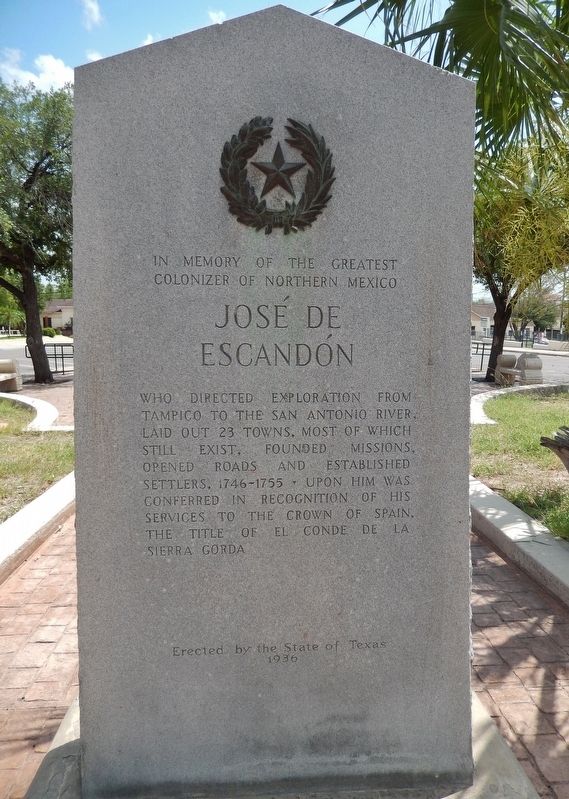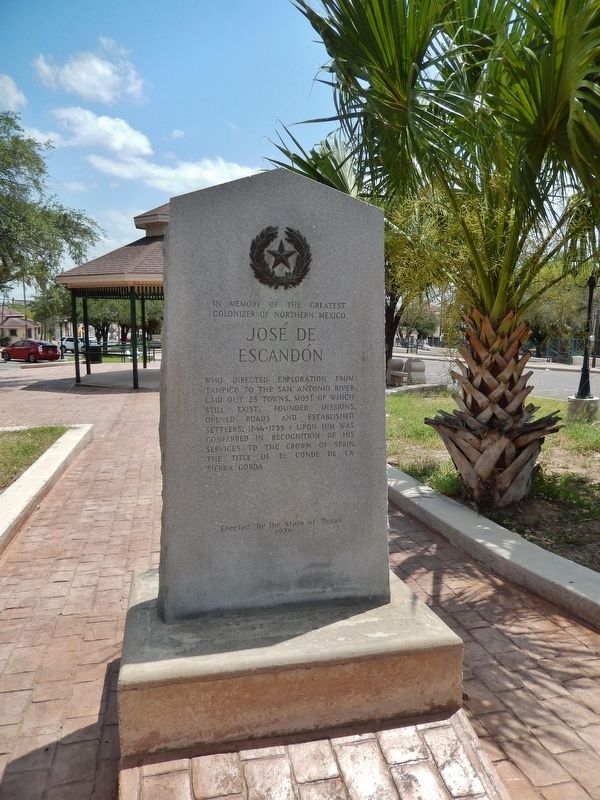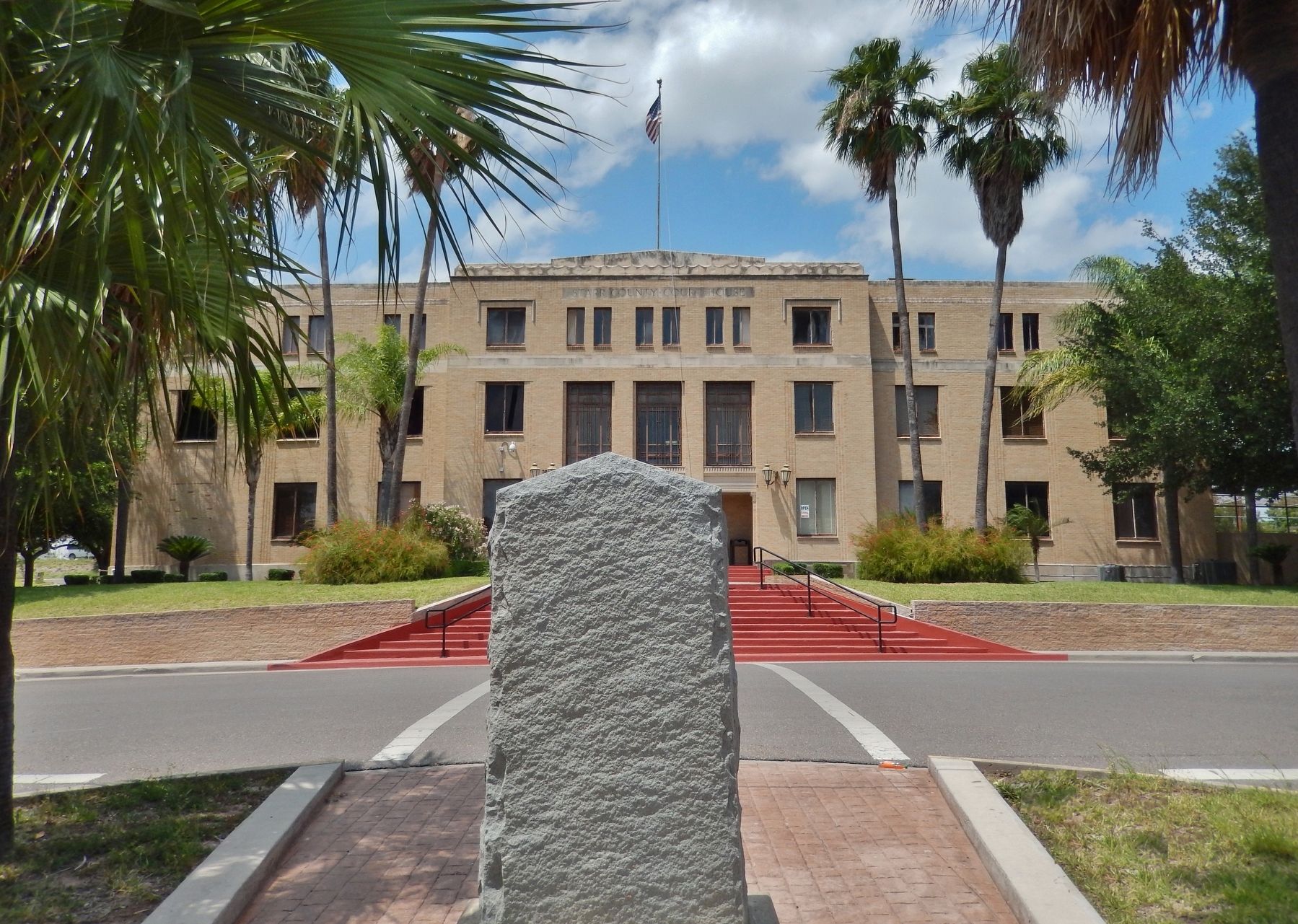Rio Grande City in Starr County, Texas — The American South (West South Central)
José de Escandón
colonizer of northern Mexico
José de
Escandón
Who directed exploration from
Tampico to the San Antonio River,
laid out 23 towns, most of which
still exist, founded missions,
opened roads, and established
settlers, 1746-1755. Upon him was
conferred in recognition of his
services to the crown of Spain,
the title of El Conde de la
Sierra Gorda.
Erected 1936 by State of Texas. (Marker Number 2853.)
Topics and series. This historical marker is listed in these topic lists: Colonial Era • Exploration • Hispanic Americans • Settlements & Settlers. In addition, it is included in the Texas 1936 Centennial Markers and Monuments series list. A significant historical year for this entry is 1749.
Location. 26° 22.888′ N, 98° 49.186′ W. Marker is in Rio Grande City, Texas, in Starr County. Marker is at the intersection of 4th Street and Britton Avenue, on the right when traveling east on 4th Street. Marker is located at the head (north end) of the plaza directly south of the Starr County Courthouse, facing the courthouse. Touch for map. Marker is at or near this postal address: 401 Britton Avenue, Rio Grande City TX 78582, United States of America. Touch for directions.
Other nearby markers. At least 8 other markers are within walking distance of this marker. Gregorio Barrera (within shouting distance of this marker); Immaculate Conception School (within shouting distance of this marker); Starr County (about 600 feet away, measured in a direct line); Rio Grande City, C.S.A (about 800 feet away); Site of Old Rancho Davis (approx. 0.2 miles away); Site of Cortina Battle (approx. 0.2 miles away); Historic Rio Grande City (approx. 0.2 miles away); Mifflin Kenedy Warehouse (approx. ¼ mile away). Touch for a list and map of all markers in Rio Grande City.
More about this marker. This is a 4-foot high, gray granite, Texas 1936 Centennial marker, included in the Texas 1936 Centennial Markers and Monuments marker series.
Also see . . .
1. José de Escandón, 1st Count of Sierra Gorda. Between December 25, 1748, the date of the foundation of Llera, and 1755, he founded over twenty towns or villages and a number of missions in the colony, including Santander, Soto la Marina, Güemes, Camargo, Reynosa, Mier, and Revilla south of the Rio Grande, and Laredo and Nuestra Señora de los Dolores hacienda north of the Rio Grande. Escandón is sometimes referred to as the "father of the lower Rio Grande Valley". (Submitted on June 30, 2018, by Cosmos Mariner of Cape Canaveral, Florida.)
2. José de Escandón. In 1746
Escandon was commissioned to inspect the country between Tampico and the San Antonio River, later known as Nuevo Santander. In January 1747 he sent seven divisions into the area, and in October he presented a colonization plan. After delays by the Spanish Bureaucracy, Escandon was made governor and captain general of Nuevo Santander on June 1, 1748. In 1749 he was made Count of Sierra Gorda and began establishing settlements along the Rio Grande. On March 6, 1753, Escandon Founded the town of Mier, and in 1755 he granted permission to Tomas Sanchez de la Barrera Y Garza to found Laredo, the largest and most successful permanent Spanish settlement in Southwest Texas. (Submitted on June 30, 2018, by Cosmos Mariner of Cape Canaveral, Florida.)
3. José de Escandón. José de Escandón, South Texas colonizer, was born in Soto la Marina, Santander, Spain, on May 19, 1700. He is known as the colonizer and first governor of the colony of Nuevo Santander, which extended from the Pánuco River in Mexico to the Guadalupe River in Texas. (Submitted on June 30, 2018, by Cosmos Mariner of Cape Canaveral, Florida.)
Credits. This page was last revised on February 14, 2024. It was originally submitted on June 30, 2018, by Cosmos Mariner of Cape Canaveral, Florida. This page has been viewed 551 times since then and 44 times this year. Last updated on February 12, 2024, by Jeff Leichsenring of Garland, Texas. Photos: 1, 2, 3. submitted on June 30, 2018, by Cosmos Mariner of Cape Canaveral, Florida. • James Hulse was the editor who published this page.


